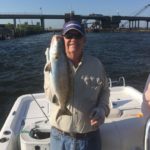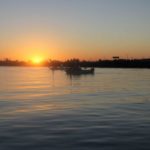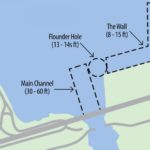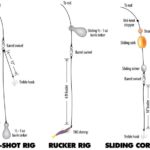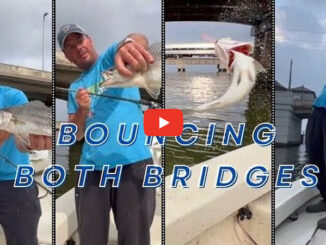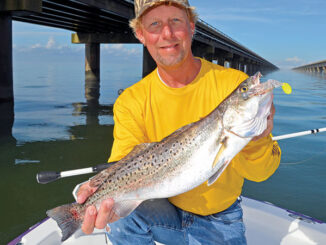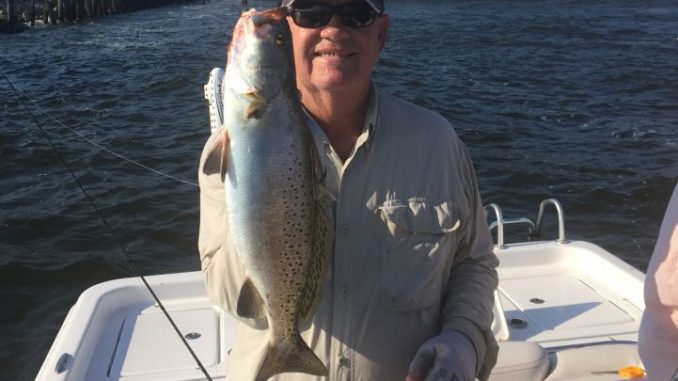
Much of the fishing in this legendary Lake Pontchartrain hotspot is concentrated in about a 1-square-mile area, so you might think location isn’t important. But you’d be wrong. Two certified trout masters share their plan of attack.
The New Orleans metropolitan area is ranked in the Top 50 cities in the country, with a population of about 1.3 million people. And situated in the middle of Orleans Parish, the waters surrounding the Seabrook Bridge (recently named the Senator Ted Hickey Bridge) make it one of the top inshore saltwater fishing areas located within the city limits of any major metropolitan area in the United States.
Referred to by locals simply as “Seabrook,” this iconic fishing hole is sure to bring back nostalgic memories for those who grew up in New Orleans loving to fish. Even today, old fish stories around docks and tackle shops can be invoked simply by uttering the word Seabrook — and it seems nearly everyone has a story to tell.
But perhaps no one in this generation has spent more time, or knows more about fishing Seabrook, than Alan “Chink” Sumas. He grew up in Gentilly, and started fishing when he was just 5. As a youngster, he loved to fish so much that he even rode the bus to go fishing at Seabrook. Now 80, he still fishes every day he can, and many of those days are spent there.
I was fortunate enough to tag along on a recent trip to Seabrook with Sumas and his long-time fishing buddy, Dr. Bob Weiss. Both men are legendary trout fishermen in Lake Pontchartrain fishing circles, and that morning, they revealed many of the secrets of this iconic trout hotspot.
With only a pink cast in the sky hinting at sunrise, we motored at idle speed from the public launch on Lakeshore Drive. To my surprise, several other boats had already arrived before us.
I looked at Sumas and said, “Did these guys sleep here?” He looked down, shook his head and said, “Man, you haven’t seen anything. Just wait a little while, and you won’t be able to fit another boat in here.
“But it doesn’t matter, we’ll get our fish.”
Weiss, on the other hand, was all business. He stared intently into the sonar and GPS screen, monitoring the bottom contour and depth, before asking, “Chink, is this where we were yesterday?” After glancing at the screen and looking around, Sumas agreed. “Yeah, Doc, this is it.” Weiss deployed the trolling motor, and with the press of a button, put the motor in “Hold” mode. There was no need for anchoring.
Fishing in a crowd
If you like Mardi Gras, then you’ll probably love Seabrook —because you’ll be fishing in a crowd. Seabrook’s great action, ease of access and small footprint make it perhaps the most crowded fishing hole in Southeast Louisiana — so bring a boatload of patience along for your trip. The good news is the crowds don’t bother the fish swimming 30 to 90 feet below the flotilla. Sumas’ advice is to be polite, because everyone is out there to have a good time and relax.
Location
The entire fishing area at Seabrook is less than 1 square mile, so you would think your exact location might not matter. But you’d be wrong.
I asked Sumas about how he selects the best spot.
“There are several areas you can fish,” he said. “The main channel which runs in the center of the canal is 30 feet to 90 feet deep. Most fish on the main channel are caught between 30 feet and 60 feet.
“Another good area to fish is the rocks along the airport wall. The water in this area is 15 to 30 feet deep. One of the most well-known areas is the Flounder Hole. It is close to the airport wall, and it is the shallowest area we fish, with water around 13- to 14 -feet deep.”
Weiss joined in saying, “When fishing Seabrook, it is very important to use your depth finder to see the drop-offs. Sonar also lets you see the depth at which the fish are holding, and the schools of bait fish.”
Once a fishing spot is selected, proper anchoring is critical (see sidebar). A trolling motor with an anchoring mode really comes in handy for this purpose.
Rigging
Seabrook is a deep-water fishing area, with water debts ranging from 15 to 90 feet. Most of the fish are staged near the bottom, so it’s necessary to get the bait down to where the fish are.
“A drop shot rig is one of the most popular rigs at Seabrook, and I use this in the main channel, especially when the tide is running hard,” Sumas said. “A Carolina rig also works. “Depending on the tide, I use anywhere between a half-ounce to 1-ounce sinker to make sure I reach the bottom. I also use a sliding cork rig along the wall and in the Flounder Hole where the water is not as deep, and where the tide does not run as hard. I normally set our sliding corks between 7 feet and 13 feet, depending on the water’s depth.”
Baits
Both men are fanatical about using live bait, and believe it is one of the most important factors for success at Seabrook.
“Live bait is a must if you want to catch fish here. Just watch the boats that are catching fish,” Sumas said. “They are all using live bait.”
Live shrimp are the easiest to obtain, but croakers are also an excellent choice, especially for big speckled trout.
If you want to try your luck using artificials, Sumas said there is a special rig that has been used for years at Seabrook.
“We call it a Rucker Rig because it was used very successfully by John Rucker, who fished Seabrook mostly from the pier. He needed to cast very long distances to reach the channel,” he explained. “It’s really just a Carolina rig with a big (1-ounce) bank sinker that slides along the line coming from the reel. You then tie on a barrel swivel and a 6-foot leader with a TKO or DOA shrimp at the end.
“You just cast the rig out and let it sink to the bottom. Then jerk hard upwards in a single motion and pause while the artificial bait slowly settles back to the bottom. Most hits will come when the bait is falling back to the bottom.”
Weiss caught several trout using this very technique during our trip.
Conditions
I asked Sumas about what months are best to fish at Seabrook.
“It usually starts around March 15, or about two weeks after the trout start showing up at the train trestles in Lake Pontchartrain,” he said. “The trout usually stay until around Christmas. As long as there are shrimp around, the fish will be there.”
As always, tides and winds are always a factor, too.
“You want some tidal movement in either direction, but not more than 1 foot of tidal range,” Sumas said. “As far as the wind, if it is more than 10 miles per hour out of the north or west, I don’t even go. You can fish a fairly strong south or east wind, but not one from the north or west.”
Species targeted
Sumas is a trout man through and through.
“I love to catch specks. So that is what gets me excited,” he said.
Specks are what draw most anglers to Seabrook, but it’s also a great place to catch many other species to fill up an ice chest, including redfish, flounder, croaker and white trout. All of these speciare caught using the same drop shot rig and either live or market shrimp.
On our trip, we caught nearly a three-person limit of specks before we ran out of live bait. We were also able to catch croakers, white trout, redfish and channel mullet — all within the city limits.
